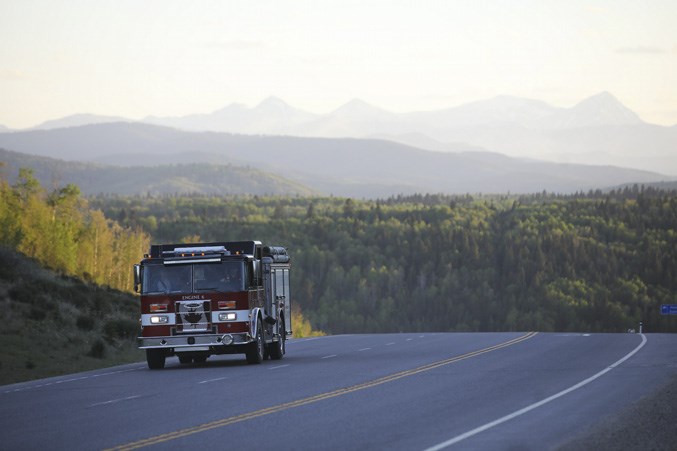A wildfire threat in the spring turned out not to be as serious as first expected, but the MD of Foothills is considering lessons learned and encouraging its residents to become FireSmart. The Champion Lakes/McLean Creek Wildfire started at the south part of McLean Creek, west of Millarville, on May 27and was considered to be held by May 29, though it still took several days to extinguish completely. Months later, the cause of the fire is still undetermined. At a rural crime and wildfire meeting at Square Butte on Nov. 8, MD Coun. Suzanne Oel said though the fire began in a different jurisdiction, the main concern for the Foothills was the forecast. “There was a forecast for 100-kilometre winds,” said Oel. “It was maybe overplayed a little bit, but we wanted to respond to it because of that forecast.” That meant the Foothills Fire Department worked closely with Alberta Agriculture and Forestry’s Alberta Wildfire division to assess risk and be prepared in the event high winds carried the fire into the Foothills. An Emergency Command Centre (ECC) was also established in High River for communications. By May 29, both the ECC and the fire department were stood down. “Thankfully Mother Nature changed her plans and lessened the winds, so we had instead what was a threat turned into an educational exercise for residents in being prepared for emergencies rather than what could have been a devastating outcome,” said Oel. Kevin Dwyer, the Province’s incident commander for the Champion Lakes fire, said when the blaze was first assessed at 10:35 a.m. on May 27 it was estimated at about 25 hectares, but had grown to 100 hectares by 3:30 p.m. “It grew quickly and we did have crews on it right away, but it did show it had potential to grow,” said Dwyer. By the second say, the fire was in “sustained action” stage and was taken very seriously, he said. A cold front moving in promised high winds, so crews worked at the fire 24/7. However, the winds didn’t materialize and the fire was classified as being held by 8 a.m. on May 29, he said. It was considered under control on June 1. There were no injuries reported and no property was lost in the fire, he said. The cause of the fire is still under investigation at this time, he said. “I can tell you most of the fires we respond to around here are man-caused,” said Dwyer. The Foothills Fire Department was ready to respond if need-be, said fire inspector Cody Zebedee. Late in the afternoon on May 27, the fire department dispatched crews to assess the possible risk and work with the Alberta Forestry team to determine a game plan, he said. “We began to kind of look at the area of the Bar Key Cee Ranch and what we call FireSmarting and doing prep work on those structures, clearing out debris off of decks and around the homes to kind of prepare for the event we had to do sprinkler protection,” said Zebedee. Sprinkler protection involves spraying a perimeter of water around a home or structure to soak the area and protect it from approaching flames, he said. The Foothills Fire Department also conducted tours of values at risk – looking for homes, properties and infrastructure potentially in the path of the fire on Highway 762, he said. First priority was to get everyone out and then start looking to protect property, he said. Though some criticized the fire department for reacting too early, Zebedee said there’s no such thing. “We’ve seen a lot of these fires over the past couple of years – Slave Lake, Fort McMurray, where maybe we kind of looked at them and said, ‘It’s still a long ways away, let’s wait,’ and maybe we waited too long.,” he said. “So being a little bit early on this one I don’t think is a bad thing, being more prepared, being ahead of the game, starting with getting information to those people.” MD residents are at risk of wildfires throughout the municipality, he said. They change from area to area – it may be threat of forest fire in the northwest region and more so fields and grasslands in the southern divisions, he said. With such diverse landscape, he said the Foothills Fire Department faces a unique challenge in dealing with wildfires. “Solving the problem, the biggest thing is what do we do before the fire actually starts – it’s not what can we do when the fire is coming, it’s what do we do ahead of the fire so we can be prepared?” said Zebedee. He encourages all communities to become FireSmart, a provincial program aimed to reduce the risk of wildfire threat to homes and other properties by clearing out trees and other materials from around the home and using non-combustible products, he said. When the fire department pulls up to a FireSmart property they may have a better opportunity to set up sprinklers and potentially save the home and other buildings, he said. It’s more difficult when there are trees against the eavestroughs and weeds coming up through the deck. Even mulch in flower beds is a threat because sparks and ash from an incoming fire could ignite the bark, he said. The more people who participate in the program the better, he said. “Not every person is going to want to FireSmart their property and that’s okay, we understand that.,” said Zebedee. “But they have to understand that if you don’t FireSmart your property and all the neighbours around you do, you could also be putting your neighbours at risk that have taken the steps to FireSmart their properties.”




